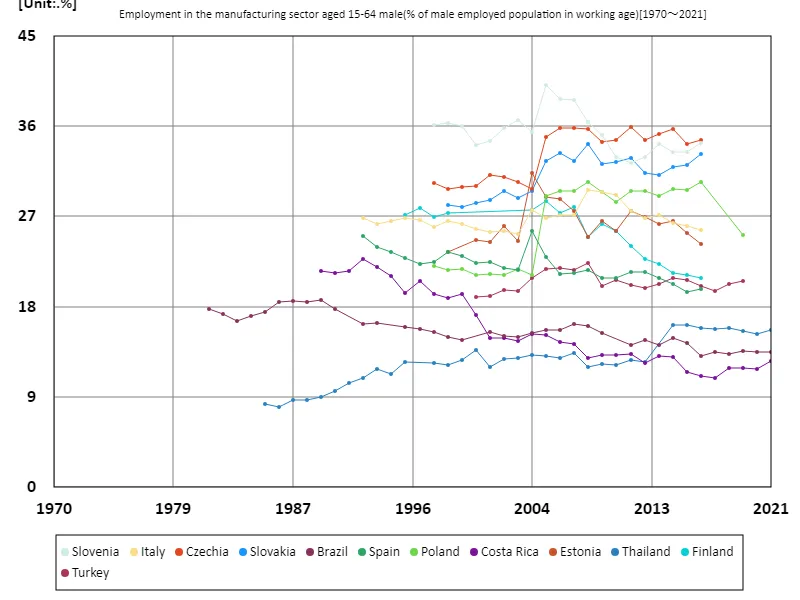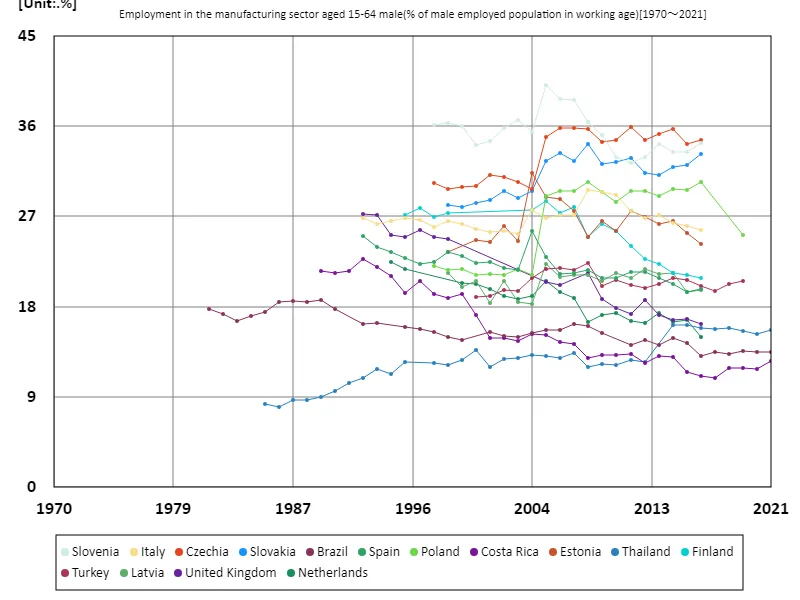- Abstract
- Employment rate in the manufacturing sector for men aged 15-64 (percentage of working-age males in the employed population)
- Employment rate in the manufacturing sector for men aged 15-64 (percentage of working-age male employed population) (Worldwide)
- Employment rate in the manufacturing sector for men aged 15-64 (percentage of working-age male employed population) (world, latest year)
- Reference
Abstract
Data for 2021 shows that Thailand has the highest employment rate in the manufacturing sector for men aged 15-64 at 15.6%. These figures indicate that Thailand has an economic structure that relies on manufacturing, which provides a strong source of employment for men. Thailand’s manufacturing industry is particularly thriving in the production of auto parts and electronic devices, which contributes to the high employment rate. In general, employment rates in the manufacturing sector vary depending on the stage of economic development and industrial structure. In many developed countries, the proportion of manufacturing tends to decrease and the proportion of service industries tends to increase, but in emerging and developing countries, manufacturing is the main engine of economic growth and often maintains a relatively high employment rate. Thailand’s high manufacturing employment rate reflects the success of its economic growth strategy and investment in manufacturing. Similar trends are evident in other emerging Asian economies, while in developed countries the manufacturing employment share is generally low and the service sector is growing in importance. Thus, the employment rate in manufacturing is an important indicator of a country’s economic structure and stage of development.
Employment rate in the manufacturing sector for men aged 15-64 (percentage of working-age males in the employed population)
According to data covering the period 1981 to 2021, Slovenia recorded the highest employment rate in the manufacturing sector for men aged 15-64 in 2005, at 40.1%. However, in subsequent decades, manufacturing employment in Slovenia has declined and now stands at 85.5% of its peak. This shift reflects structural changes in manufacturing and the maturation of the economy. Slovenia’s high peak manufacturing employment rate is indicative of economic development and industrial growth during the 1990s and early 2000s. At that time, Slovenia was experiencing economic development centered on manufacturing, with the machinery and metal processing industries being particularly thriving. However, the decline since 2005 is due to several factors. In developed countries, the proportion of manufacturing is declining as it is increasingly being replaced by services and information and communications technology industries. Slovenia is no exception, where globalization, automation and the growth of the service sector have led to a decline in the relative importance of manufacturing. This trend is also being seen in many developed and emerging markets, where economic diversification and technological advances are impacting manufacturing employment rates. The decline in manufacturing employment in Slovenia is an important indicator of economic maturity and changes in the industrial structure.


The maximum is 40.1%[2005] of Slovenia, and the current value is about 85.5%
Employment rate in the manufacturing sector for men aged 15-64 (percentage of working-age male employed population) (Worldwide)
From 1981 to 2021, employment in the manufacturing sector for men aged 15-64 years reached a peak of 40.1% in 2005 in Slovenia but has now fallen to 85.5% of that peak. This decline reflects a shift in the structure of manufacturing employment. In the early 2000s, Slovenia relied on a rapidly growing manufacturing sector, but subsequent economic maturation and structural changes have reduced the relative importance of manufacturing. This trend is common across many countries, with an ongoing shift from manufacturing to services and technology sectors. Globalization, automation, and digitalization are reducing manufacturing jobs, with the service sector becoming the main source of employment. The Slovenian case is part of this broader change, with a declining share of manufacturing employment, but also overall diversification of the economy and growth in high value-added industries. As such, the employment rate in manufacturing is an important indicator that reflects the stage of economic development and changes in industrial structure.


The maximum is 40.1%[2005] of Slovenia, and the current value is about 85.5%
Employment rate in the manufacturing sector for men aged 15-64 (percentage of working-age male employed population) (world, latest year)
According to 2021 data, Thailand has the highest employment rate in the manufacturing sector for men aged 15-64 at 15.6%, compared to an overall average of 10.3% and a total of 144%. This figure indicates that manufacturing plays a significant role in men’s employment. Thailand’s high employment rate is due to the fact that manufacturing is at the heart of the economy, particularly in the production of electronic devices and auto parts. Manufacturing is a major sector supporting Thailand’s economic growth, which translates into high employment rates for men in the manufacturing sector. Meanwhile, the global average of 10.3% indicates a relative decline in manufacturing employment in many countries. This is due to economic diversification and growth in services and information technology, and reflects manufacturing jobs making up a declining share of the overall job market. The combined figure of 144% indicates that manufacturing is a significant source of employment across multiple sectors and continues to offer significant employment opportunities, particularly in emerging economies. These trends reflect changes in the global economy as well as the evolution of each country’s economic structure and job markets.


The maximum is 15.6% of Thailand, the average is 10.3%, and the total is 144%



Comments